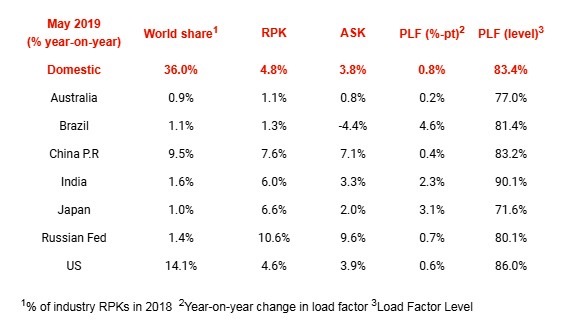
aTP- Arab tourism portal News
Geneva – The International Air Transport Association (IATA) announced global passenger traffic results for May showing that demand (measured in revenue passenger kilometers, or RPKs) rose 4.5% compared to the same month in 2018. This was in line with the revised April traffic growth of 4.4% and above the recent trough of 3.1% year-on-year growth recorded in March. However, it remains below the 20-year average growth rate of around 5.5%. Capacity (available seat kilometers or ASKs) climbed by a modest 2.7% and load factor rose 1.4 percentage points to 81.5%, surpassing last year’s record load factor of 80.1%.
“Passenger demand growth has slowed compared to the past two years. This is in line with slumping global trade, rising trade tensions and weakening business confidence. In this challenging environment, airlines are managing capacity carefully in order to optimize efficiency,” said Alexandre de Juniac, IATA’s Director General and CEO.
International Passenger Markets
International traffic demand rose 4.3% in May over the year-ago period, which was down from 5.1% growth in April. All regions recorded growth, led by airlines in Latin America. Total capacity climbed 2.1%, with load factor jumping 1.7 percentage points to 80.4%.
European carriers’ May demand climbed 5.4% over May 2018, a deterioration from the 7.7% year-over-year growth recorded in April. Capacity rose 4.6% and load factor was up 0.7 percentage point to 84.2%, which was the highest among regions. Most of the region’s growth, however, occurred in the first half of 2018, with demand moving broadly sideways since then.
Asia-Pacific airlines saw their traffic rise 4.0% in May compared to the year-ago period, an improvement over the 2.9% increase in April. Capacity increased 3.0%, and load factor edged up 0.8 percentage point to 78.6%. This is the second consecutive monthly increase in demand, but it still represents a soft outcome in a region that regularly saw double-digit growth rates over the past few years. The US-China trade tensions continue to weigh upon growth in the region.
Middle East carriers’ May demand growth decelerated to 0.8% compared to a year ago, from 3.3% annual growth recorded in April. This partly reflects the impact of the structural changes that are underway in the industry in the region. May capacity plunged 6.1%, and load factor soared 5 percentage points to 73.0%.
North American airlines’ traffic rose 4.8% in May compared to May 2018, a slowdown from 5.6% annual growth in April. Capacity climbed 2.7% and load factor strengthened 1.7 percentage points to 83.6%. The comparatively strong US domestic economy, and US dollar is helping to offset any trade-related softening in international travel.
Latin American airlines experienced a strong 6.7% increase in traffic in May compared to the same month last year, which was well up from 5.1% growth in April. Passenger demand is currently holding up well, despite a challenging economic backdrop in a number of countries. Capacity climbed 4.0% and load factor jumped 2.1 percentage points to 84.0%, second highest among the regions.
African airlines posted a 2.1% traffic rise in May compared to the year-ago period, which was up from just 1.1% growth in April. Capacity climbed 0.1% and load factor increased 1.3 percentage points to 67.0%. Traffic between Africa and Europe continues to expand strongly, but economic growth in South Africa – a key regional economy and air transport market– contracted sharply in the first quarter and this is adversely impacting air passenger demand.
Domestic Passenger Markets
Domestic traffic increased 4.8% in May compared to May 2018, well above the 3% year-over-year rise recorded in April. Russia was the only market to see double-digit demand growth. Domestic capacity rose 3.8% and load factor climbed 0.8 percentage point to 83.4%.
Russia’s domestic traffic rose 10.6% year-over-year, which is up slightly from the 10.4% year-over-year growth recorded for April. Russia continues to benefit from favorable economic conditions and lower airfares.
Japan’s domestic traffic rose 6.6% in May, up from 4.1% growth in April and the strongest performance since summer 2017. Fare stimulation, combined with robust economic growth, contributed to the result.
The Bottom Line
“Aviation is the business of freedom, connecting people and trade and creating new opportunities for growth and development. But to be effective, the business of freedom relies on borders that are open to the movement of people and goods—and aircraft. In recent weeks, we have seen extensive airspace closures owing to political tensions. These closures have contributed to longer and less efficient routings, higher operating costs and increased carbon emissions. Without any compromise on safety, it is vital that governments work to minimize airspace closures so that the Business of Freedom can continue to deliver its benefits as efficiently as possible,” said de Juniac.









